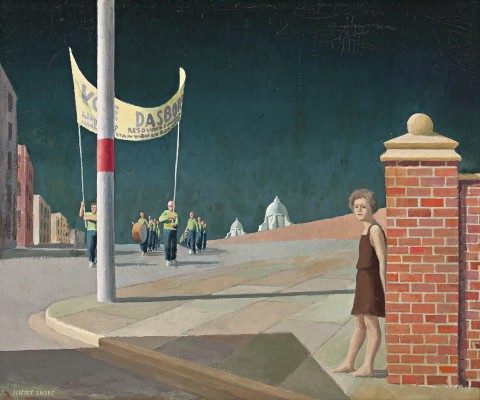ST KILDA, 1959
JEFFREY SMART
oil on canvas on board
51.0 x 60.5 cm
signed lower left: JEFFREY SMART
bears inscription verso: S.T. Green
bears inscription on frame verso: 24/4/93 / … TB GREEN / PAITER [sic] JEFFREY SMART / ST GREEN / …
Private collection, Sydney, acquired directly from the artist, April 1959
Private collection, Sydney, acquired from the above April 1993
Sotheby’s, Melbourne, 21 August 1995, lot 13
Private collection, Melbourne
Quartermaine, P., Jeffrey Smart, Gryphon Books, Melbourne, 1983, cat. 350, p. 106
We are grateful to Stephen Rogers, Archivist for the Estate of Jeffrey Smart, for his assistance with this catalogue entry.
St Kilda, 1959 is the only known image of a Melbourne subject by Jeffrey Smart painted before he moved permanently to Europe in 1963. It comes from a particularly fertile period for the artist as he negotiated his busy life as a much-loved art educator with the ABC with the burgeoning fame that his art had been attracting over much of the previous decade. His imagery already stood in stark contrast to much of contemporaneous Australian art with its exceptional precision and masterly technique, combined with a stark clarity to its vision, where characters seem frozen into ‘separateness’ having stumbled onto a stage set and been momentarily caught in the act.
Smart always acknowledged that his art was anchored around an intimate understanding of classical technique, citing artists as diverse as Piero della Francesca, Tintoretto, Braque and Cézanne as significant influences. At the heart of his compositions is a precise geometry aligned around the Golden Mean, first introduced to him by the pioneer Modernist Dorrit Black, his teacher at the South Australian School of Arts and Crafts. Smart furthered his education with an extended journey through the United States and Europe from 1948, studying for six months with the French artist Fernand Léger the following year. On his return, he moved to Sydney in July and in December 1950, at the recommendation of Bernard Smith, was offered the role as art educator for the ABC Radio children’s programme The Argonauts. In a nod to the creator of the Golden Mean, he chose the name Phidias and spent the next decade as an extremely influential character in the cultural life of Australia, including television appearances after its introduction in 1956. This also meant interstate travel and it is assumed that the original inspiration for St Kilda came from one such journey, probably in 1958.
With the twin domes of the St Kilda Baths forming the central focal point, a political rally marches down the elevated roadway of Jacka Boulevard. To the right, next to the wall of the old footbridge, a young woman seems more interested in the artist than she is in the strident clamor of drums and marchers. It is presumably an incident witnessed during the state election held in Victoria in 1958 though the name beginning ‘Dasbor…’ is an apparent fiction for no delegate with a similar name contested the event.1 Smart has also tinkered with the view as this particular angle of sight does not exist, but his manipulation magnifies the intensity of the drama, structured as ever on the underlying Golden Mean. Interpretation also remains open, a deliberate strategy by the artist who rebutted any attempts to ‘explain’ his paintings. As his friend, the novelist David Malouf, explained: ‘The figures in his paintings puzzle us so much, because they don’t have any real relationship with the landscapes. They are like ghosts who’ve wandered in, from another time. He paints them as if there is some story, some anecdote, and yet there is none. People are teased by this, and search for one’.2 St Kilda is an important precursor for a suite of notable paintings which feature solitary figures in urban settings surmounted by glimpses of the upper levels of distant buildings, such as On the roof, 1961; Trumper Park, 1961; and Coopers Park, 1962. The culmination of the series, Cahill Expressway, 1962, is Smart’s most famous image with its enigmatic one-armed man who likewise stares back at the viewer as an elevated roadway sweeps off to the left. St Kilda was never publicly exhibited, having been sold directly from the studio to Smart’s stockbroker in April 1959, and is now offered for sale for the first time since its last appearance on the market in 1995.
1. See: https://en.wikipedia.org/wiki/Candidates_of_the_1958_Victorian_state_ele...
2. Hawley, J., ‘Jeffrey Smart’, Encounters with Australian Artists, University of Queensland Press, Brisbane, 1993, p. 108
ANDREW GAYNOR
